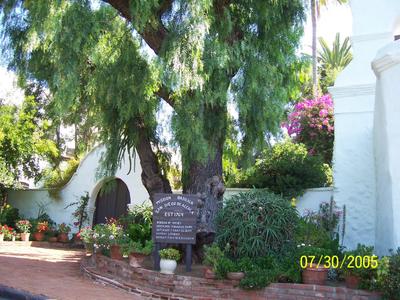
The sky sparkled last Saturday morning, and, because our mission to San Diego had been accomplished (see previous post below), we had time to tour. The youngster had been studying the history of California and asked if we could visit the first California mission, San Diego de Alcala. I readily agreed, as I do with any of the kids’ requests if they possess a hint of educational merit; my acquiescence is made easier because such requests are so unusual.
The mission was seven miles from our hotel, just off Highway 8. We entered through the gift shop, which was staffed by the white-haired ladies who seem to run church gift shops everywhere. The lady at the register gazed at me over her glasses and announced firmly that there was a “suggested donation” of five dollars for the two of us. My wallet opened obediently, and we exited the door to a mock-up of Father Serra’s living quarters.
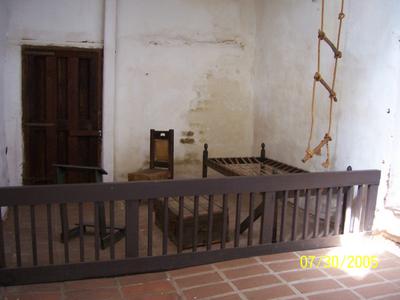
Mission San Diego was founded by Father Junipero Serra in 1769. Junipero Serra is a “pivotal figure in California history” due to the missions he built from San Francisco to San Diego. The missions became centers of commerce and exported cattle and grain to outposts of the Spanish empire.
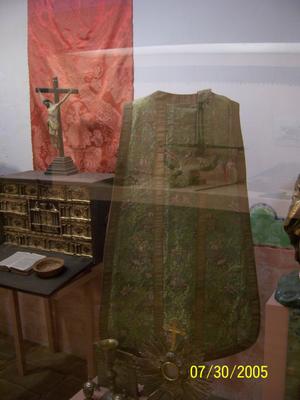
Priests' vestments are displayed in the museum.
Schools, parks, and highways throughout California have been named for Junipero Serra. As with most historical figures who had a hand in spreading Western civilization to the Americas, controversy has dogged further efforts to honor Father Serra. He is the most prominent of the priests who collaborated with the Spanish army to advance Spain’s interests in the New World. To be sure, they weren’t as brutal as the soldiers but were known to administer severe discipline and even beatings on the Indians who worked at the missions.
The Spanish presence spread the Gospel, as well as disease, to the Native American population. The original wooden structures were burnt, perhaps by the local Indians, not all of whom welcomed the visitors from Europe, and the mission was relocated a few years later to its permanent site. The adobe buildings were destroyed and rebuilt over the centuries, and the mission had been abandoned when restoration began in the 1920’s.
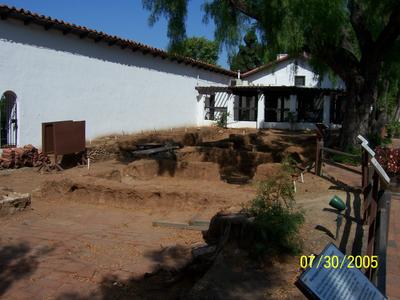
Excavation continues at the site every week.
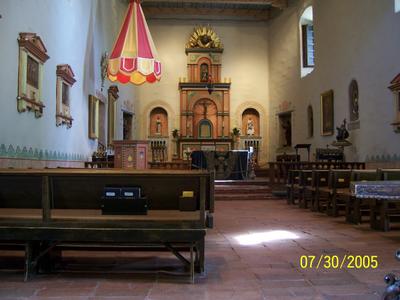
Services are held every Sunday in the rebuilt church.
Now the site, which includes a museum, gardens, and church, is an oasis in the midst of the bustling, burgeoning Southern California community outside its walls.
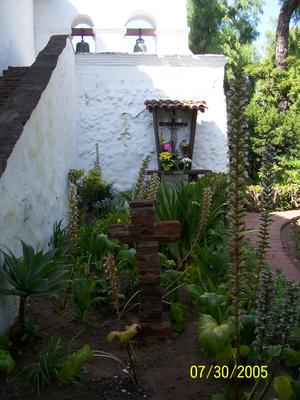
Graves in the garden next to the sanctuary
An afterthought: we are too quick to judge historical events through the prism of our 21st century sensibilities. Whether we are viewing the European colonization of North America, the Crusades, or even the climactic battles of World War II, we are horrified by the deeds performed by actors on all sides. No, Father Serra and other builders of California don’t fit my definition of sainthood. But I do think the right side ultimately triumphed, and the world today is a better place because it had. © 2005 Stephen Yuen
2 comments:
Great photos! I was here for my sixth birthday in 1976, and I remember running with my brother to the top of the stairs to see the bells. Do you know if the stairs can still be climbed? As a six year old, I thought it was exposed, but I hope attorneys haven't ruined it. I'd like to take my kids this year.
Anon, although I have fond memories of my little excursion, my memory isn't THAT good. Someone at info@missionsandiego.com may be able to answer your question. Good luck--hope you have a great trip with your family.
Post a Comment